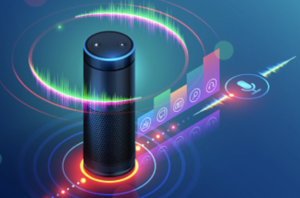 For decades, the “Era of Voice” has been just around the corner. In contact centers, natural language speech has been poised to achieve primacy over touch-tone input to interactive voice response (IVR) systems so brands can greet callers with “How may I help you?” rather “Your call is important to us…. press 1 if you agree”. At home, voice assistants on smartphones stand ready to be invoked on a regular basis to answer questions, initiate phone calls, play music, originate texts and carry out daily commerce.
For decades, the “Era of Voice” has been just around the corner. In contact centers, natural language speech has been poised to achieve primacy over touch-tone input to interactive voice response (IVR) systems so brands can greet callers with “How may I help you?” rather “Your call is important to us…. press 1 if you agree”. At home, voice assistants on smartphones stand ready to be invoked on a regular basis to answer questions, initiate phone calls, play music, originate texts and carry out daily commerce.
Industry giants Google, Amazon and Microsoft joined long-time speech technology specialists like Nuance and Lumenvox to deliver new technologies, language models and cloud-based architectures. They boosted the accuracy of speech recognition, delivered more human-like text-to-speech renderings and employed natural language processing and machine learning to greatly improve “understanding” of a speakers intent, often across multiple languages. In these endeavors, the giants are joined by smaller, innovative firms, too numerous to mention here without offending someone, who deliver measurable improvements in accuracy across multiple languages, dialects and business uses cases.
To use the language of Newtonian Physics, the Potential Energy surrounding Voice builds with every new entrant, technological advancement and service offering. Historically, these have been met with the equally powerful physical principle of Inertia. As Sir Isaac observed in the late 17th century, objects at rest tend to stay at rest and objects in motion tend to stay in motion. Voice has clearly been a slow starter.
Yet, as a product of the investments and refinements described above, Voice is building potential energy that will translate to real momentum in relatively short order in 2021. Here’s what’s new:
Microphones are everywhere
It’s the IoT’s (Internet of Things) world, we’re just fortunate to live in it. Investment in 5G networks and “smart endpoints” mean that the world is poised for voice activation and voice-based activity. As our recent survey revealed that one out of five of the companies we surveyed are already offering voice services through public kiosks. That pales when compared to the 4 out of 5 offering voice input as an option for their mobile apps and more than half with services offered through smart speakers. For planning purposes, virtually all major brands have voice services on their radar.
No-Touch is Permanent
Needless to say, hygiene is important these days. Restaurants offer touchless take-out. Shoppers now wave their credit cards near the point-of-sale terminals at local stores, restaurants and banks. In our survey, 60% of respondents listed “more hygienic” as a major “end-user benefit” for voice-enabled products, services or apps.
Voice Data is Conversational Intelligence
New speech recognition and analytics technology do nothing short of redefine business definition of “The Voice of The Customer.” There is no need for post-conversation surveys to rate an agent or the outcome of a call when accurate transcription and analysis of core conversations reveals the purpose of the call, encapsulate or summarizes its outcome and even reveals emotional state of both the caller and the agent. Spoken input, rather than post-call surveys, recognize the true Voice of the Customer.
Sonic Branding is For Real
Audio branding has been a big deal for major brands since the inception of radio. Yet the melding of branded voices for intelligent virtual assistants as part of broader marketing initiatives is just starting to accelerate. (See Opus Research’s recent global survey report: “The Business Value of Customized Voice Assistants”) Chances are that today’s voice-savvy individuals, who are regular users of Siri, Google Assistant or Alexa, may be familiar with a short list of choices around designating a gender or nationality for their favorite voice assistant. We’re observing that the marketing departments of major brands are taking interest in the image their voice assistant projects to their customers. They can designate the cadence of its speech, the level of empathy imparted in its prosody or the sophistication of its vocabulary. Where only mobile app developers, contact center administrators or IT departments used to be involved in selecting voice platform vendors. It is becoming a “must” for execs from marketing, branding, advertising and media agencies to join.
Speech and natural language processing specialists are poised to prove me right. Consensus is building among leading brands that incorporating conversational virtual agents into their branding strategy is now a must.
Categories: Intelligent Assistants

 NiCE Interactions 2025: Agentic AI, Better Data, and a Whole Lot of Partnership
NiCE Interactions 2025: Agentic AI, Better Data, and a Whole Lot of Partnership  Getting It Right: What AI Agents Actually Mean for Customer Support (Webinar)
Getting It Right: What AI Agents Actually Mean for Customer Support (Webinar)  Beyond the Basics: How AI Is Transforming B2B Sales at TP
Beyond the Basics: How AI Is Transforming B2B Sales at TP  Five9 Launches Agentic CX: Toward AI Agents That Reason and Act
Five9 Launches Agentic CX: Toward AI Agents That Reason and Act